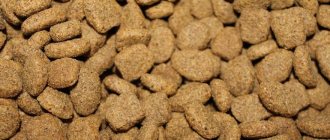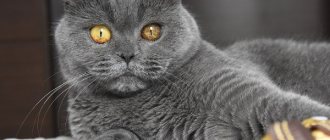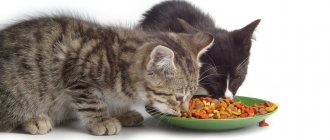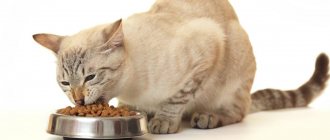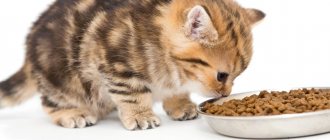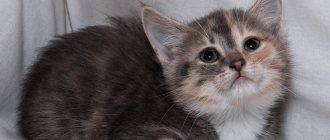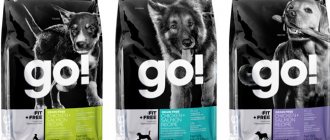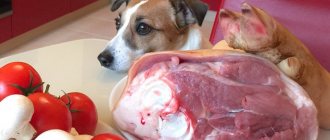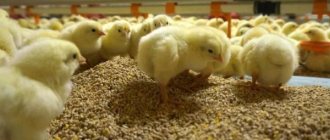Many cat owners (of various breeds) are interested in the possibilities of feeding their pets wet food. In accordance with the general classification, canned cat food is classified as wet food. This type of food has many advantages, but there are also disadvantages. Initially, it is important to note that mixing types of food (dry and wet or wet and natural) is strongly not recommended. Switch the animal to one type of feeding and then stick to it if the cat is active, mobile, and does not have obvious signs of food intolerance (diarrhea, vomiting, allergic reactions, etc.).
On the website www.zootovary.com you can find a wide range of inexpensive wet cat food. Below are the main recommendations regarding regular feeding. It is highly recommended that you adhere to them to ensure your pet's health.
Feeding frequency
In the world of cats, there are both picky eaters who turn their nose up at food and gluttons who demand a new portion every 2 hours.
When forming a diet, you should not focus on your pet’s appetite, otherwise you may face the problem of obesity. It is necessary to strictly follow the established feeding standards. The amount of feed consumed depends on the following factors:
- Age;
- Health status;
- Weight;
- Breed.
Kittens under 6 months of age require more food (relative to body weight) to grow and develop than adult cats. Babies should be fed 3-4 times a day in small portions.
Adolescents over 6 months old are given food 2-3 times a day, and an adult cat 1-2 times a day. With the onset of old age, cats' appetite decreases, which is associated with a slowdown in metabolism and deterioration of the condition of teeth and gums. Cats 7 years old and older need only one meal.
The above applies to healthy animals. Diseases and health problems make adjustments to the diet.
Appetite worsens in cats with disorders of the gastrointestinal tract and kidneys. There is no need to force your pet to eat. First you need to take him to the vet.
There are breeds that require more food due to their large body size or increased mobility. These include British and Scottish, Maine Coon, Ragdoll.
After sterilization (castration), the pet's metabolism slows down. He becomes prone to gaining excess weight. A sterilized cat should be fed less often or in small portions. If you are going to give her food, choose a diet brand.
A pregnant and recently given birth cat, on the contrary, is fed more and more often, since the body requires a lot of nutrients.
How do you know if your pet's weight is normal? Pay attention to the sides. The “glow” of the ribs indicates that the nutrition is insufficient. If the ribs cannot be felt and the sides clearly protrude, the pet is overweight.
Principles of organizing a proper diet
If the owner has doubts about when and how often to feed the pet, it is worth adopting several techniques for optimally organizing cat dinners, which are recommended by veterinary experts.
Following these rules will help avoid digestive problems and protect against the development of obesity:
Two feedings throughout the day is the answer to the question of how many times a day you need to feed your pet kitty. It is preferable to do this in the morning and evening
Please note that an adult cat should be fed according to this regimen. A small kitten needs to be fed five to six times a day
They are transferred to two meals a day after six months of life. Feeding at the same hours. This rule disciplines the cat; he does not get used to begging from the master's table. Limiting feeding time. It takes a cat 20 minutes to satisfy his hunger and get enough. If during this time he has not eaten all the food, it is still better to remove the bowl of food. This will help avoid unnecessary overeating. If the cat begins to lazily eat the rest of the food, it means that he is already full enough. Single serving limit. You should not add a daily portion of food at one feeding.
Regardless of the time and number of feedings, fresh water should always be fully available to the cat.
Dry food
Most owners give their pet dry cat food. This type of nutrition has a number of advantages.
- Balanced in composition. Pressed granules contain the necessary meat proteins, vitamins, microelements, amino acids, and taurine. Problems may arise when preparing your own diet from natural foods.
- Individual approach. On the shelves of pet stores there are various lines: dietary, for kittens, cats with sensitive digestion, sterilized, and those with tartar.
- Ease of calculation. The packaging indicates the recommended feeding frequency and amount of food depending on the age and weight of the pet.
- Long shelf life.
- Saving the owner's time.
Dry food should not be mixed with natural products. To digest raw meat (offal, fish) and pellets, the body secretes different enzymes. Their combination will increase the load on the liver and pancreas. Mixing balanced granules with natural products will lead to an excess of some substances and a deficiency of others.
Make sure your cat has access to clean drinking water, as dry food does not contain liquid. Some pets prefer to drink from wide and deep bowls. Change the water every day.
Do not suddenly switch your pet from one type of dry kibble to another.
Which food is better
Dry food lines are divided depending on price and quality into economy-class, premium-class, and super-premium class food.
Everyone knows “Whiskas”, “Kite-kat”, “Friskies”, “Felix”. Bright, memorable packaging with a happy cat's face, relatively low price. Advertised economy-class food meets the standards of competent marketing more than quality nutrition. Although in terms of composition they contain the necessary proteins, vitamins and microelements, low-quality raw materials are used for production.
The main sources of protein are not meat and offal, but feathers, hooves, animal bones, and grains. Economy class food contains additives that are not stated on the packaging, which improve the taste of the product (like monosodium glutamate in fast food) and cause narcotic addiction in cats.
Eating economy-class dry food leads to urolithiasis, problems with the kidneys and digestive organs. Don't skimp on your pet's food!
Buy exclusively premium and super-premium food. They contain meat protein, healthy carbohydrates, amino acids and antioxidants. Read the ingredients on the package. A good product contains at least 30% meat protein, plant components - rice, oats (not wheat and corn), amino acids, antioxidants.
Good dry food lines (judging by veterinarian reviews and composition) include the following:
- “Fitmin For Life” (Czech Republic);
- “Royal Canin” (preferably French-made, not Russian);
- "1st Choice" (Canada);
- "Hills" (USA, Netherlands);
- "Blitz" (Russia);
- "Leonardo" (Germany);
- Arden Grange (UK);
- "Profine Adult Cat" (France);
- "Orijen" (Canada);
- "Iams" (USA).
The above premium and super-premium products are not advertised. Some of them cannot even be bought at a pet store, but can only be ordered online on the suppliers’ website.
How many times a day should you feed your cat dry food?
The general rule is 1-2 times a day (morning and evening) in medium-sized portions.
Norm of dry food per day
Please check the packaging of the specific product for exact information. General indicators of feed norms per day are reflected in the table.
| Weight, kg) | Daily dose (g) | Kitten age (months) | Daily dose (g) |
| 3 | 45 | 1-2 | 30-50 |
| 4 | 55 | 2-4 | 40-65 |
| 5 | 65 | 4-6 | 55-70 |
| 6 or more | 12 g per 1 kg of weight | 6-12 | 60-80 |
How to feed
When choosing cat food - dry or wet - you should be guided by the composition. Wet food for cats, the best in composition, should contain primarily meat: the more of it, the better the quality of the food and the more effective it will be for the health of the pet.
Proper nutrition is the key to your pet’s health
Among the elements of natural products you need to add:
- vegetables. It is a valuable source of vitamins and microelements, as well as fiber. They support digestion and increase the nutritional value of food;
- eggs. In some cat foods, eggs are an additional source of protein. In addition to this, they also contain vitamin A, D, iron and polyunsaturated fatty acids;
- taurine is an amino acid found in meat that is essential for keeping your cat healthy. Promotes the proper functioning of the heart and digestive system. In addition, it plays an important role in building immunity and the functioning of the animal’s nervous system;
- vitamins, minerals, trace elements have a beneficial effect on the condition of the cat’s skin, coat and general well-being.
When planning your cat's or kitten's diet, it is important to consider that a good wet food should not contain cereal, sugar, preservatives or artificial colors and flavors. The simple composition and many useful nutrients will allow the cat to live a long time and not get sick.
Wet food
Wet food has approximately the same composition as dry food, plus it contains water. Suitable for pets who are prohibited from eating dry kibble for health reasons (urolithiasis, tartar), and for cats who are not inclined to drink a lot of liquid. A significant disadvantage is the high price.
Rules for feeding wet food:
- It can only be combined with dry food of the same line, following the dosages indicated on the packages.
- Do not store uneaten pellets at room temperature. They should be placed in a tightly sealed container and stored in the refrigerator.
How many times a day should I feed my cat wet food?
The general rule is 1-2 times a day. You can give your cat a portion of dry food in the morning and wet food in the evening. Kittens are fed 3-4 times a day.
Wet food intake per day
Depends on the specific product and the age of the pet. Super-premium food is the most nutritious, so less quantity is required per serving. Average indicators (grams of feed per day) are given in the table below.
| Weight, kg) | Daily requirement (g) | Kitten age (months) | Daily requirement (g) |
| 3 | 190-200 | 2-3 | 170-210 |
| 4 | 230-240 | 3-6 | 210-300 |
| 5 | 250-260 | 6-9 | 210-300 |
| 6 or more | 300 | 9-12 | 170-255 |
In one bowl or separately
There is no single recommendation on this matter from veterinarians and well-known manufacturers. Some believe that it is possible to mix different types of food in one bowl. Others insist that time should pass between the intake of dry and wet food. Since no research has been conducted on this issue, there is no clear answer.
What food is best to feed a cat: advice from veterinarians
Most recommendations highlight the following points:
- separation of food makes it possible to accurately track how much and what was given to the pet in terms of volume, composition, how much the animal eats, what can be mixed and what cannot;
- if you alternate food, it is easier to track the animal’s reaction to one or another type of food: what caused the allergy, indigestion and other undesirable effects;
- mixing feed leads to spoilage of the dish and loss of taste characteristics much faster.
Important! It is worth trying a mixed feeding option first, then separate feeding. You need to track which option was more preferable for the cat and make a choice in its favor.
Natural products
Super-premium food is more expensive than meat, and there is no guarantee that you will buy high-quality pellets. To be calm about your cat’s health, you need to choose a natural type of feeding and take the time to study suitable products.
The basis of the diet is meat protein (at least 50%, preferably 75%). It is found in the following products:
- Beef;
- Veal;
- Turkey;
- Chicken;
- By-products (liver, kidneys, ventricles, lungs);
- Rabbit.
It is better to give the meat raw in small pieces, after freezing it first. Boil the offal. Pork is not suitable as it is too fatty. Meat is given to the pet every day.
You need to be careful with fish. If you offer your cat such a product, then no more than once every 2 weeks, only sea food, boiled, without bones. Frequent consumption of fish leads to urolithiasis, and river species are infested with worms.
Boiled offal and meat are mixed with cereals. Raw meat is given as a separate meal. Suitable cereals include rice, buckwheat, and oats. Corn, wheat and barley are difficult for your pet's stomach to digest because they contain gluten. Cereals are offered to your pet 2-3 times a week.
Additionally, the cat is given the following products:
- Quail eggs (1 time per week);
- Cottage cheese (2-3 times a week);
- Fermented milk drinks (kefir, sour cream, natural yogurt, cream). If there are no digestive disorders, they can be offered every day;
- Vegetables: carrots, zucchini, beets, cabbage, cucumbers, broccoli (every day);
- Sprouted oat grass (every day).
When feeding naturally, vitamin and mineral complexes for cats are included in the diet. The exact dosage and frequency of administration is determined by the veterinarian.
How many times a day should I feed my cat natural foods?
A healthy adult pet will need 2-3 meals. Kittens are fed more often, in small portions.
The daily weight of food consumed for an adult cat is 5% of its weight. At the same time, at least 50% should be meat and offal. They are supplemented with either cereals and vegetables, or dairy products. More detailed indicators in grams are given in the table below. For kittens, the daily portion is distributed into 4-6 doses depending on age.
Daily intake of natural products for cats, grams
| Adult cat weight (kg) | Meat and offal (daily) | Cereals (2-3 times a week) | Vegetables (daily) | Fermented milk drinks (daily, if there are no problems with the gastrointestinal tract) |
| 3 | 80 | 45 | 10-15 | 70 |
| 4 | 100 | 60 | 20-30 | 80 |
| 5 | 125 | 75 | 25-35 | 100 |
| 6 | 150 | 90 | 30-40 | 130 |
Examples of diet calculations
On the back of the Orijen and Acana packages is a feeding chart that includes recommendations for kittens. You will find the same information on the product pages in our catalogue. Let's take as an example Orijen Cat & Kitten dry food with chicken, turkey and ocean fish.
Feeding rate Orijen Cat&Kitten Cat
Let’s make a reservation right away that kittens are cats and female cats under the age of 52 weeks (12 months). The compilers of the diets divided them into two main age groups: 5–20 weeks and over 20 weeks, since the growth rates and food needs of kittens of different ages differ significantly.
Babies should be breastfed until about 5 weeks of age. If this is not possible, they are fed cat milk replacer from a bottle with a nipple. You can gradually accustom your kitten to dry food only after teeth appear. At first, it is recommended to soak the granules in warm water and knead with a fork. Then a little dry food is added to the moistened food, gradually leading the baby to a complete transition to “drying”.
As can be seen from the table, the amount of product in grams is calculated in accordance with the weight of the kitten. Babies under 20 weeks of age need 60 g of dry product per 1 kg of weight, and after reaching this milestone - half as much. Here are examples of calculating the daily norm for different ages.
Example 1
Keep in mind that this amount of feed is not for one feeding, but for a day. That is, it needs to be divided by the planned number of meals (54: 3 = 18 g). It turns out that when feeding three times a day, 18 grams of dry product should be poured into the bowl each time.
Example 2
As you can see, the norms for 2 and 6 months differ slightly, although the weight of the second kitten is several times greater. This is explained by the fact that by 20 weeks cats have practically reached adult size and are no longer growing as intensively as in the first months of life.
Norms for kittens by month of life
The decision on how many times a day to feed a kitten depends on the baby's age in months. During growth and development, the cat's body requires more feedings throughout the day.
From birth and during the first month
If a newborn kitten is separated from its mother for any reason, then the responsibility of feeding the kitten falls on the shoulders of the person. If you couldn’t find another cat that could feed you with its own milk, you should feed the kitten without a mother a special formula. You can use infant formula for newborns.
It is forbidden to give a newborn kitten whole cow's milk in the first month of life; this is a very heavy food.
To develop the sucking reflex, it is advisable to use a bottle when feeding. You can try feeding from a pipette.
During the first three days you need to feed every two hours, including at night. Then, by the 10th day of life, the interval between feedings is increased to 4 hours. For the first two weeks, the daily intake of formula for a kitten is 30-40 ml per 100 g of baby’s weight.
A one-month-old kitten should be fed exclusively with formula, increasing its volume to 50-55 ml per 100 g of weight by day 30. Then start feeding him adult food.
1-2 months
The age of a kitten from a month to two months is the time to accustom it to food in pieces. By the end of the second month, the kitten should eat about 200 g of food, which is divided into 5 feedings. You can offer him oatmeal or rice milk porridge with the addition of a chicken egg. If ready-made food does not cause digestive upset, then you can completely switch the kitten to natural feeding.
2-3 months
A 2 month old kitten needs to be fed 4 times a day. He can already eat about 300 g of food, cut into small pieces. For example, you can offer minced meat.
3-4 months
A 3 month old kitten needs to be fed 3 times a day. The total volume of food eaten is approximately 360 g. Until this age, pieces of dry food must be soaked in water when feeding. At 3 months, kittens change their teeth and can already be introduced to solid food.
4 months and older
By this time, the kitten’s menu should consist of 75% meat protein foods.
Under no circumstances should you feed your kitten raw or fresh meat. This threatens protein intoxication or infection with parasites.
By six months, you can gradually transfer the grown kitten to two meals a day.
Price issue
Looking at the cost of super-premium products, many cat owners get scared. However, if you understand the pricing process, the dosage of such foods and other nuances, then it turns out that feeding your pets with high-quality diets is not so expensive. An additional advantage of such food is the cat’s excellent health, small and non-smelly piles of feces in the tray, and small daily portions.
You can compare food from the most popular brands - Whiskas, Royal Canin and Akana, calculating the product consumption for a cat weighing 4 kg:
- Whiskas. A healthy animal should eat 410 g of wet food per day, which is from 20 to 25 rubles. per day, that is, on average - 90 rubles. and 2700 per month. The average daily intake of dry Whiskas granules is 70 g, but there is information on the packaging that this amount should fill 250 ml of the bowl. And if you use a scale, you will need 30-50 g more food per day to fill a cup and satiate your pet. At this consumption, the monthly ration supply should be 3300 g. On average, such a package costs about 600 rubles. But the cat needs to be pampered, and this means 1-2 more bags, respectively, the amount increases to 1200-1800 rubles.
- Royal Canin. An adult cat that lives indoors needs three 85 g bags of wet food per day. But this is if she does not receive dry granules. The price of the product varies from 50 to 60 rubles, which means that a pet needs a little less than a hundred spiders for a month, with a total cost of about 5,000 rubles. It turns out to be quite an expensive pleasure. However, few people treat their pets exclusively with pates and pieces of meat in sauce, without giving dry food. Usually these products are combined, giving granules and 1 pouch of wet food per day, and some do without the latter. As for feeding your cat only granules, a 55 g portion per day will be enough for her. You will need 1700-2000 g per month, the cost of packaging such a mass is 850-950 rubles. Surprisingly, this amount of food is really enough for your pet. The combination of drying - 40 g per day and 1 pouch will cost a little more - more than 2000 rubles. But there is no particular need to feed your pet with wet diets every day; the granules contain enough meat components.
- Akana Grasslands. It is a super-premium food and holistic. An adult cat needs to eat 60 g of product per day. A package of 1800 g will be required per month, the average price of the product is 900-1100 rubles. There are no wet diets.
Additional expenses. When calculating the benefits of a particular product, we must not forget about possible additional expenses. For example, if the cat eats low-quality food, then costs will increase because more frequent visits to the veterinary clinic will be required. It is rare to do without treatment, including surgery.
And keeping a pet with chronic diseases - gastritis, urolithiasis and other diseases will cost much more. After all, this ends with a lifelong diet, prevention and other measures.
Most often, the life cycle ends much earlier, and the pet “passes away”, suffering from severe pain.
Also watch the video how much food a cat needs per day and how often to feed a cat:
Is there enough food for the cat?
It's also important to weigh your cat periodically to make sure he hasn't gained extra pounds or lost a lot of weight, both of which can negatively impact his health. For most domestic cats, the standard weight is 2-4.5 kg, so if the pet’s weight exceeds these limits, you need to change your approach to feeding. It could be:
- changing the type of food;
- increasing/decreasing the number of meals.
You can also tell if your pet is getting enough food by looking at its ribs:
- if the ribs protrude too much, this is a sign of malnutrition and excessive thinness;
- if the ribs cannot be felt, this is a sign of obesity.
Normally, a cat's ribs should be covered with a small layer of fat and not “shine through” the skin, but they can be easily felt. For pregnant animals, an increase in the amount of fat on the sides is quite acceptable.
Each animal’s body is unique, so it is important not to blindly follow the recommendations, but to select a feeding regimen for your pet taking into account its individual characteristics.
